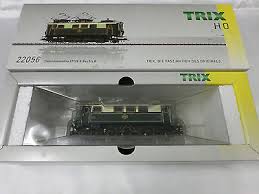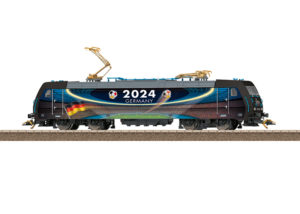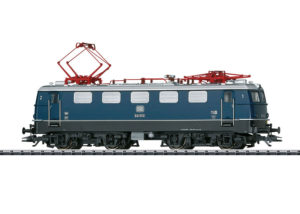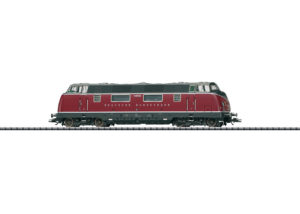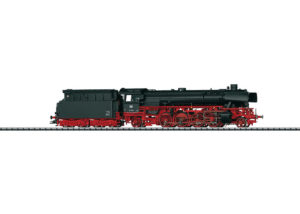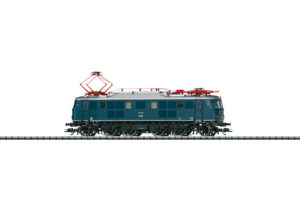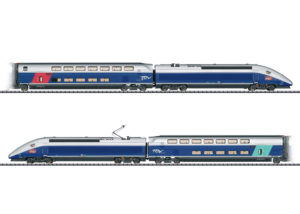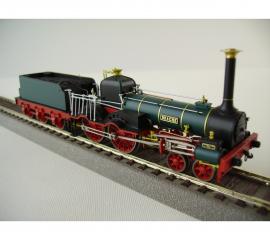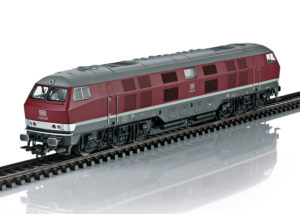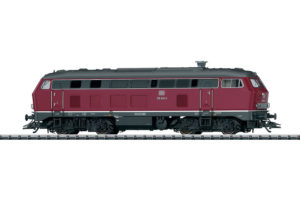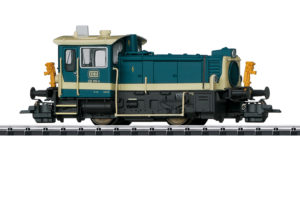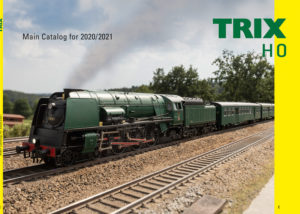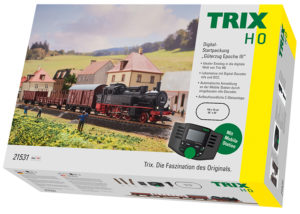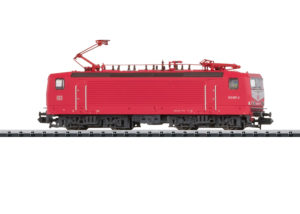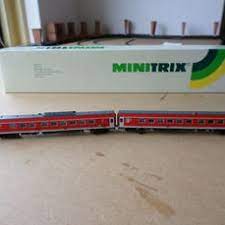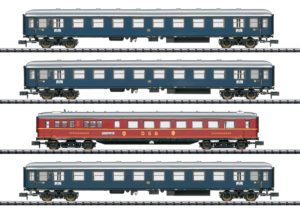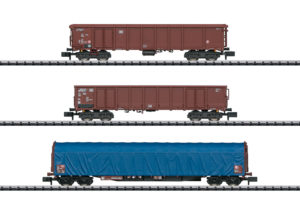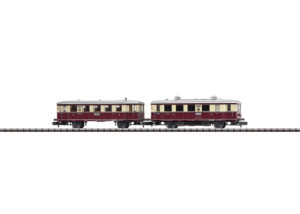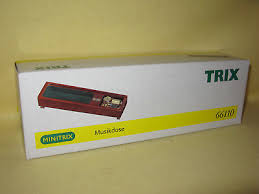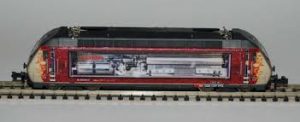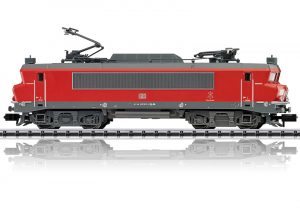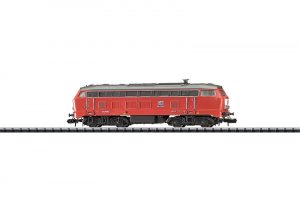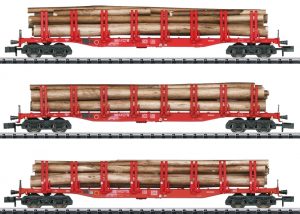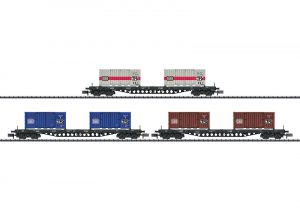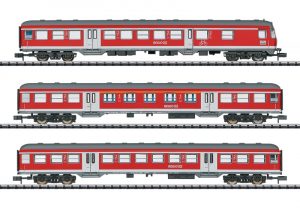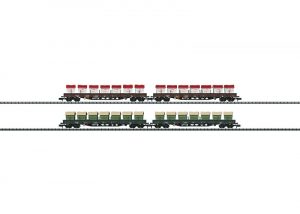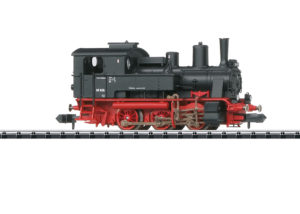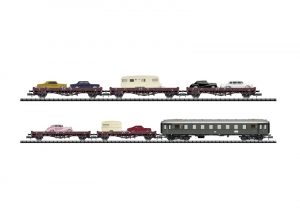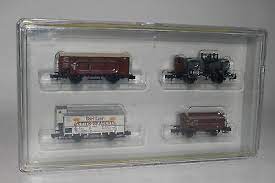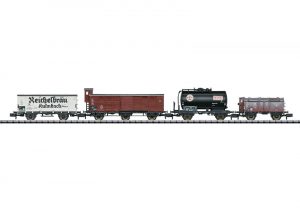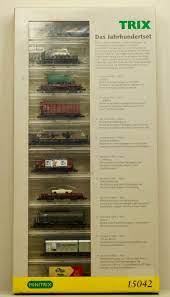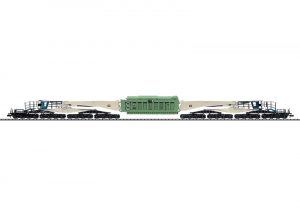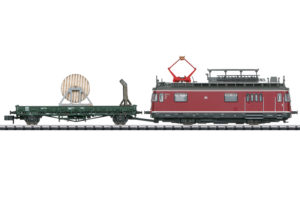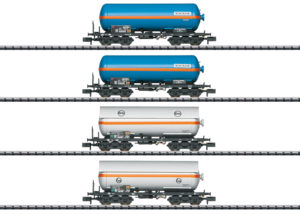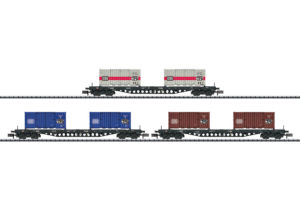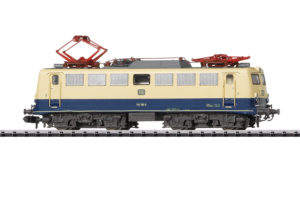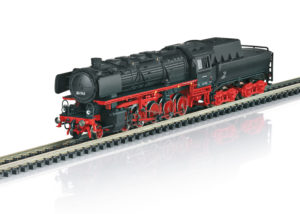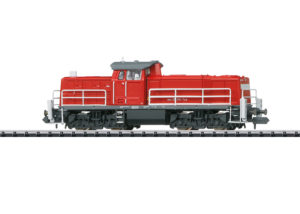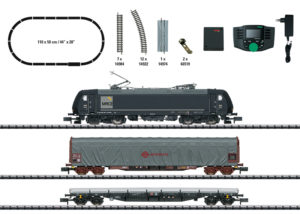Class 185.2 Electric Locomotive
Prototype: Class 185.2 electric locomotive in a fictitious version on the occasion of the European Soccer Championship to take place in 2024 in Germany.
Highlights
- Attractive design on the occasion of the European Soccer Championship to take place in 2024 in Germany.
- Pantographs and coupler loops are plated in high-quality 24-carat gold.
- Certificate of authenticity included.
- Locomotive body constructed of metal.
- Separately applied grab irons on the ends of the locomotive.
- Digital decoder with extensive light and sound functions.
Electric Locomotive
Prototype: German Federal Railroad (DB) class E 41 standard design electric locomotive. Steel blue basic paint scheme. Version with 3 simple lamps, Schweiger ventilation grills with vertical fins, and continuous rain gutter. Road number E 41 012. The locomotive looks as it did around 1958.
Highlights
- Digital decoder and extensive operating and sound functions included.
- Steel blue basic paint scheme like the first 71 locomotives in the series.
Diesel Locomotive.
Prototype: German Federal Railroad (DB) class V 200.0. B-B wheel arrangement, built starting in 1953. Use: Medium and heavy express and fast passenger trains
Model: Era III. The frame and body are constructed of die-cast metal. The locomotive has a digital connector and a 5-pole motor. 2 axles powered. Traction tires. The locomotive has NEM coupler pockets. Length over the buffers 21 cm / 8-1/4″.
Steam Freight Locomotive with a Tender.
Prototype: German Federal Railroad (DB) class 41 steam freight locomotive with a tender and with oil firing. Rebuilt version with a new design, high-efficiency boiler, Witte smoke deflectors, DB Reflex glass lamps, inductive magnet on one side of the locomotive, warning stripes on the buffer plates, and rebuilt tender with an oil bunker. Road number 41 356. The locomotive looks as it did around 1962.
Highlights
- Completely new tooling.
- Especially finely detailed metal construction.
- Open bar frame and many separately applied details.
- High-efficiency propulsion with a bell-shaped armature, in the boiler.
- Many operating and sound functions that can be controlled digitally.
Electric Locomotive.
Prototype: German Federal Railroad (DB) class E 19 electric locomotive. In the blue paint scheme with older design headlights. The locomotive looks as it did around 1966 Road no.: E 19 01. Use: Express and fast passenger service
Highlights
- 5-pole motor with a skewed armature and a flywheel for silky smooth running characteristics.
- Highly detailed plastic body.
- Buffer beam can be fully equipped for display.
- Warm white LEDs for headlights, they change over with the direction of travel, the lights facing the train can be turned off in digital operation for prototypical operation.
- 21-pin digital connector.
TGV Euroduplex High-Speed Train
Prototype: French State Railways (SNCF) TGV Euroduplex (train à grande vitesse) high-speed train, in the version for service between Paris and Munich. 2 powered end cars (TK1 and TK2), 1 bi-level transition car (R1), 1st class, 1 bi-level transition car (R8), 2nd class. Powered rail car train road number 4709. The train looks as it does in Era VI.
Highlights
- Tooling change for the version as a TGV Euroduplex for the route Paris – Munich.
- Scale 1? reproduction.
- Factory-installed LED interior lighting.
- Extensive sound functions included.
- Both end cars powered.
Era III Freight Train” Digital Starter Set
Prototype: German State Railroad (DR/GDR) class 74 tank locomotive, type Omu Association design gondola, a type Gr Association design boxcar of the German State Railroad (DR/GDR), and a German Federal Railroad (DB) type Rlmms 58 stake car in temporary use in the GDR.
Highlights
- The ideal way to get started in the digital world of Trix H0.
- Automatic registration in the Mobile Station with a built-in digital decoder.
- Easy to set up C Track layout.
Class 143 Electric Locomotive
Prototype: German Railroad, Inc. (DB AG) electric locomotive, road number 143 007-3. B-B wheel arrangement, built starting in 1984. The locomotive looks as it did around 1994. Use: Freight and passenger trains
Highlights
- New tooling.
- Many sound functions.
- Warm white LEDs for the lighting.
- Cab lighting.
- Headlights / marker lights can be shut off.
Class 89.8 Steam Locomotive
Model: The locomotive has a built-in digital decoder for operation with mfx and DCC. 3 axles powered, warm white LED headlights that change over with the direction of travel, can be controlled digitally, and will work in analog operation. The locomotive body and frame are constructed of die-cast zinc.Powered Catenary Maintenance Rail Car with a Catenary Construction Car
Prototype: German Federal Railroad (DB) class TVT 6251 Mz (Flm Mainz) powered catenary maintenance rail car. Included are a work platform and double arm pantograph. A low side car is included as a catenary construction car. Used for servicing and checking catenary. The unit looks as it did after 1957.
Highlights
- Extensive operation and sound functions.
- Catenary construction car with a typical freight load.
“Compressed Gas Tank Car” Car Set
Prototype: 4 four-axle compressed gas tank cars of different designs with and without heat shields. Privately owned cars for the firms Eva Railroad Service Provider, Inc., Düsseldorf, and WACKER Chemical. All of the cars are used on the German Federal Railroad (DB). The cars look as they did around 1988.
“Silberlinge” / “Silver Coins” Car Set
Prototype: German Railroad, Inc. (DB AG) type Bn 719 commuter car, 2nd class, type ABn 703 commuter car, 1st/2nd class, and type BDnrzf 740 commuter cab control car (car number: 50 80 82-34 083-9, preserved at the DB Museum in Koblenz). Car route Mannheim – Koblenz.
Class 140 Electric Locomotive
Prototype: German Federal Railroad (DB) standard design electric locomotive, road number 140 186-8. Ocean blue / ivory basic paint scheme. Version with double lamps, plastic rain gutters above the end windows and cab doors, Klatte design air grills, undivided engine room windows with rubber gaskets, and end grab irons. The locomotive looks as it did around 1979. Use: Freight, commuter, and long-distance passenger trains.
Highlights
- Body constructed of die-cast zinc.
- Digital sound with many functions.
Class 44 Steam Locomotive
Prototype: German Federal Railroad (DB) steam locomotive with a tender, road number 44 1143 (2-10-0 design) with a type 2´2´ T 30 tub-style tender. The locomotive looks as it did around 1950. Use: Heavy freight trains.
Highlights
- Tooling variation.
- Metal construction.
- Motor with a bell-shaped armature and a flywheel.
- Steam locomotive sound.
- Running gear lights.
- Flickering firebox lights.
Class 294 Diesel Locomotive (Remotored)
Prototype: German Railroad, Inc. (DB AG) heavy diesel switch engine, road number 294 594-7, with home base lettering for DB Schenker Rail Germany, Inc. in Mannheim, Germany. Remotored version (Motor MTU 8V 4000 R41), including additional side handrails and new ventilation system. The locomotive looks as it did around 2015. Use: Switching work and freight trains.
Highlights
- Body and frame constructed of metal.
- Additional handrails.
- Cab lighting.
- New motor sound.


